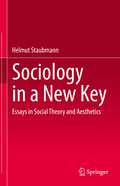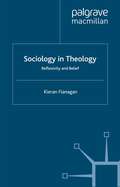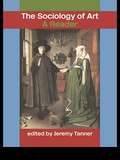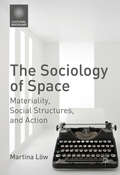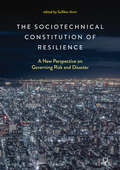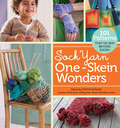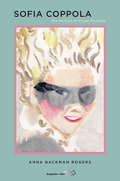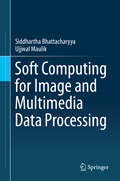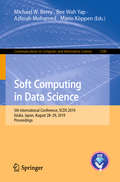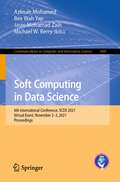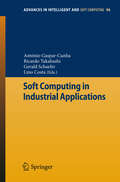- Table View
- List View
The Socio-spatial Design of Community and Governance: Interdisciplinary Urban Design in China
by Sam Jacoby Jingru Cyan ChengThis book proposes a new interdisciplinary understanding of urban design in China based on a study of the transformative effects of socio-spatial design and planning on communities and their governance. This is framed by an examination of the social projects, spaces, and realities that have shaped three contexts critical to the understanding of urban design problems in China: the histories of “collective forms” and “collective spaces”, such as that of the urban danwei (work-unit), which inform current community building and planning; socio-spatial changes in urban and rural development; and disparate practices of “spatialised governmentality”. These contexts and an attendant transformation from planning to design and from government to governance, define the current urban design challenges found in the dominant urban xiaoqu (small district) and shequ (community) development model. Examining the histories, transformations, and practices that have shaped socio-spatial epistemologies and experiences in China – including a specific sense of community and place that is rather based on a concrete “collective” than abstract “public” space and underpinned by socialised governance – this book brings together a diverse range of observations, thoughts, analyses, and projects by urban researchers and practitioners. Thereby discussing emerging interdisciplinary urban design practices in China, this book offers a valuable resource for all academics, practitioners, and stakeholders with an interest in socio-spatial design and development.
Sociology in a New Key: Essays in Social Theory and Aesthetics
by Helmut StaubmannThis book presents essays that address fundamental issues in social and cultural theory by viewing them through the lens of aesthetic theory. Drawing on the aesthetic theories of Theodor W. Adorno, Gregory Bateson, Jean-Marie Guyau, Talcott Parsons and Georg Simmel, it suggests a new take on basic sociological concepts and methodologies. The chapters cover a wide range of topics, including the sensuality of social action, social construction of unreality, and The Rolling Stones’ enduring success as a reflection of our society and culture. The book’s title Sociology in a New Key refers to a classic work by Susanne K. Langer, whose Philosophy in a New Key argued for a reorientation of modern philosophical thought based on a thorough account of symbolism in general and of the arts in particular. In this way, the basic ideas and assumptions of the philosophical tradition are transposed to new understandings and perspectives. After all, it was Georg Simmel himself who claimed to have gained several of his general theoretical insights “via the detour of reflections on the essence of art.” The book will appeal to scholars and students of the sociology of the arts and music, and to anyone interested in the intersection of social theory and aesthetics.
Sociology in Theology: Reflexivity and Belief
by K. FlanaganThis is an original study of the sociological imagination in regard to visual culture. It explores the reflexive dimensions of choice over seeing or not seeing in relation to paintings, images and islands. Bourdieu, Goffman and Simmel provide the basis for insights into how reflexivity in sociology has unexplored theological implications.
The Sociology of Architecture: Constructing Identities
by Paul JonesStates have long been active in commissioning architecture, which affords one way to embed political projects within socially meaningful cultural forms. Such state-led architecture is often designed not only to house the activities of government, but also to reflect political-economic shifts and to chime with a variety of ‘internal’ and ‘external’ publics as part of wider discourses of belonging. From the vantage point of sociology, this context necessitates critical engagement with the role of leading architects’ designs and discourses relative to politicized identity projects. Focusing on the mobilization of architecture in periods of social change, The Sociology of Architecture uses critical sociological frameworks to assess the distinctive force added to political projects by architects and their work. Through engagement with a range of illustrative examples from contested contemporary and historical architectural projects, Paul Jones analyses some of the ways in which architects have sought to position their architecture relative to state projects and wider publics. A central objective of the book is to situate major architectural projects as a research agenda for sociologists and others interested in the relationship between power, culture, and collective identities. Adopting a critical approach to such questions, The Sociology of Architecture frames architecture as a field of contestation over symbolic and material resources, which in turn provides an entry point for questioning the inextricably political ways in which collective identities are constructed, maintained and mobilized.
Sociology of Art: A Reader
by Jeremy TannerIntroducing the fundamental theories and debates in the sociology of art, this broad ranging book, the only edited reader of the sociology of art available, uses extracts from the core foundational and most influential contemporary writers in the field. As such it is essential reading both for students of the sociology of art, and of art history. Divided into five sections, it explores the following key themes: * classical sociological theory and the sociology of art * the social production of art * the sociology of the artist * museums and the social construction of high culture* sociology aesthetic form and the specificity of art. With the addition of an introductory essay that contextualizes the readings within the traditions of sociology and art history, and draws fascinating parallels between the origins and development of these two disciplines, this book opens up a productive interdisciplinary dialogue between sociology and art history as well as providing a fascinating introduction to the subject.
Sociology of Art: A Reader
by Jeremy TannerIntroducing the fundamental theories and debates in the sociology of art, this broad ranging book, the only edited reader of the sociology of art available, uses extracts from the core foundational and most influential contemporary writers in the field. As such it is essential reading both for students of the sociology of art, and of art history. Divided into five sections, it explores the following key themes: * classical sociological theory and the sociology of art * the social production of art * the sociology of the artist * museums and the social construction of high culture* sociology aesthetic form and the specificity of art. With the addition of an introductory essay that contextualizes the readings within the traditions of sociology and art history, and draws fascinating parallels between the origins and development of these two disciplines, this book opens up a productive interdisciplinary dialogue between sociology and art history as well as providing a fascinating introduction to the subject.
A Sociology of Culture, Taste and Value
by S. StewartThis book explores sociological debates in relation to culture, taste and value. It argues that sociology can contribute to debates about aesthetic value and to an understanding of how people evaluate.
The Sociology of Space: Materiality, Social Structures, and Action (Cultural Sociology)
by Martina LöwIn this book, the author develops a relational concept of space that encompasses social structure, the material world of objects and bodies, and the symbolic dimension of the social world. Löw’s guiding principle is the assumption that space emerges in the interplay between objects, structures and actions. Based on a critical discussion of classic theories of space, Löw develops a new dynamic theory of space that accounts for the relational context in which space is constituted. This innovative view on the interdependency of material, social, and symbolic dimensions of space also permits a new perspective on architecture and urban development.
Sociology of the Arts in Action: New Perspectives on Creation, Production, and Reception (Sociology of the Arts)
by Arturo Rodríguez Morató Alvaro Santana-AcuñaThis edited collection carries out an extensive coverage of the sociology of arts’ most characteristic thematic areas (production, creation, the artwork, and reception) across an important range of artistic fields, from the most traditional to the more unusual. It makes an argument for the theoretical creativity and empirical expansion that characterizes the study of contemporary sociology of the arts. Such creativity is present in the increasingly predominant approach to a sociology of the arts in action, in all areas of inquiry within the discipline. The range of theoretical paradigms evoked is rich, analysing several of the most important theoretical frameworks currently handled in the discipline (Bourdieu, Becker, Peterson, ANT), and combining them with the works of many other influential contemporary specialists (De Nora, Hennion, Lamont, Menger and Born et al.). The book also establishes links to less known theoretical frameworks and some from different fields including economic sociology,microsociology, ethnomethodology, semiotics, and cultural history. The volume argues that Spanish-speaking scholars are now at the forefront of new developments in the field of the sociology of the arts, and is the first effort to gather research by these influential Spanish-language scholars in a single volume for an English-language audience.
Sociopolitical Aesthetics: Art, Crisis and Neoliberalism (Radical Aesthetics-Radical Art)
by Kim CharnleySince the turn of the millennium, protests, meetings, schoolrooms, reading groups and many other social forms have been proposed as artworks or, more ambiguously, as interventions that critique art's autonomy. The historical origins of these practices can be traced back to the avant-gardes of the early 20th century, which hoped to revolutionise both art and life. It is clear, however, that the social and political turbulence of the present requires a different framework of analysis than any of those that have been developed to interpret the artistic developments of a century ago. This book will survey the resurgence of sociopolitical aesthetics, tracing key currents of theory and practice, and mapping them against the dominant motif of the last decade: crisis. Drawing upon key artists and theorists within this field – including Gregory Sholette, John Roberts, Dave Beech, Gail Day, Martha Rosler, Kirstin Stakemieir and Marina Vishmidt – this book will locate the configurations of sociopolitical aesthetics that might energize struggles that are emerging within a radically altered political terrain.
Sociopolitical Aesthetics: Art, Crisis and Neoliberalism (Radical Aesthetics-Radical Art)
by Kim CharnleySince the turn of the millennium, protests, meetings, schoolrooms, reading groups and many other social forms have been proposed as artworks or, more ambiguously, as interventions that critique art's autonomy. The historical origins of these practices can be traced back to the avant-gardes of the early 20th century, which hoped to revolutionise both art and life. It is clear, however, that the social and political turbulence of the present requires a different framework of analysis than any of those that have been developed to interpret the artistic developments of a century ago. This book will survey the resurgence of sociopolitical aesthetics, tracing key currents of theory and practice, and mapping them against the dominant motif of the last decade: crisis. Drawing upon key artists and theorists within this field – including Gregory Sholette, John Roberts, Dave Beech, Gail Day, Martha Rosler, Kirstin Stakemieir and Marina Vishmidt – this book will locate the configurations of sociopolitical aesthetics that might energize struggles that are emerging within a radically altered political terrain.
The Sociotechnical Constitution of Resilience: A New Perspective on Governing Risk and Disaster
by Sulfikar AmirThis book considers the concept of resilience in a global society where coping with the consequence and long term impact of crisis and disaster challenges the capacity of communities to bounce back in the event of severe disruption. Catastrophic events such as the 9.11 terrorist attack, the Fukushima nuclear disaster, and the volcano eruption in Central Java entailed massive devastation on physical infrastructures, and caused significant social and economic damage. This book considers how the modern sociotechnological system facilitating human activity defines how societies survive and whether a crisis will be short-lived or prolonged. Drawing on the concept of sociotechnical resilience, this book closely examines a range of events North America, Asia, Australia, and Europe. By presenting the successes and failures of sociotechnical resilience, it offers important insights and practical lessons to build better and comprehensive understandings of resilience in a real-world setting, significantly contributing to the study of disaster resilience.
The Sociotechnical Constitution of Resilience: A New Perspective on Governing Risk and Disaster
by Sulfikar AmirThis book considers the concept of resilience in a global society where coping with the consequence and long term impact of crisis and disaster challenges the capacity of communities to bounce back in the event of severe disruption. Catastrophic events such as the 9.11 terrorist attack, the Fukushima nuclear disaster, and the volcano eruption in Central Java entailed massive devastation on physical infrastructures, and caused significant social and economic damage. This book considers how the modern sociotechnological system facilitating human activity defines how societies survive and whether a crisis will be short-lived or prolonged. Drawing on the concept of sociotechnical resilience, this book closely examines a range of events North America, Asia, Australia, and Europe. By presenting the successes and failures of sociotechnical resilience, it offers important insights and practical lessons to build better and comprehensive understandings of resilience in a real-world setting, significantly contributing to the study of disaster resilience.
The Sock Knitting Bible: Everything you need to know about how to knit socks
by Lynne RoweThe ultimate guide to every aspect of sock knitting for knitters of all abilities. Whether you've never picked up a double pointed needle in your life or you've already started your sock knitting journey, this book will help you on your way. The Sock Knitting Bible will break down all the different techniques and show wannabe sock knitters that there is nothing to be scared of. Covering everything from casting on to colourwork and everything in between, knitters won't find a better reference book for all their sock knitting needs. Whether you want to knit toe up, cuff down or even two at a time socks, we've got it covered. Sock knitting is the perfect portable project too - once you know the basics you can dip in and out until they are flying off your needles! There are a lot of sock pattern books out there but this is more than a pattern book - it covers all the different techniques and methods for sock knitting! There are step-by-step instructions for all the various sock knitting techniques so that instead of sounding like a foreign language making socks becomes your second language. There are also step-by-steps instructions for three basic socks so that you can follow them even if you are an absolute beginner and then start to choose your preferred method for sock making. Author Lynne Rowe explains what kind of yarns are best suited to different styles of sock and shares her techniques for how to get the best finish. We also look at the different kinds of tools available for making socks so you can experiment with double pointed needles, the magic loop method and small circular needles as well as innovative new products such as flexible dpns until you find your own favourite method. With this book you can put that beautiful skein of hand dyed yarn you couldn't resist to good use by making the perfect pair of socks because in addition to the extensive techniques there are also 10 projects by some of the most exciting and talented sock designers, illustrating a number of the different knitting methods and styles. Here you will find stripes, fair isle, cables, lacy, sparkly and snuggly socks: a pattern for all your needs. It won't be long before you are delighting your friends and family with your new found skills - just be sure to make yourself a pair too! But be warned: sock knitting is addictive!
Sock Yarn One-Skein Wonders®: 101 Patterns That Go Way Beyond Socks! (One-Skein Wonders)
by Judith DurantSock yarn isn&’t just for socks anymore! Veteran knitter Judith Durant presents 101 original projects that can be created from just a single skein of sock yarn, including adorable baby clothes, warm hats, beautiful scarves, and even a dog sweater. A quick and creative way to use up leftovers, many of these projects knit up in less than three hours. Adapted from designs contributed by yarn shops and crafters from throughout North America, knitters of all types will delight in these fun and stylish creations.
Sofia Coppola: The Politics of Visual Pleasure
by Anna Backman RogersA feminist study of the mood, texture, tone, and multifaceted meaning of director Sofia Coppola’s aesthetic through her most influential and well-known films. A Choice Outstanding Academic Title 2019 “With this book Rogers has produced a sophisticated and impassioned analysis of Coppola’s work… Rogers’s main argument – that Coppola manipulates pleasurable images to unsettle rather than mollify us – is utterly convincing. If nothing else, this certainly hits home in relation to my own enchantment with Coppola’s work.”—Bright Lights Film Journal All too often, the movies of Sofia Coppola have been dismissed as “all style, no substance.” But such an easy caricature, as this engaging and accessible survey of Coppola’s oeuvre demonstrates, fundamentally misconstrues what are rich, ambiguous, meaningful films. Drawing on insights from feminist philosophy and psychology, the author here takes an original approach to Coppola, exploring vital themes from the subversion of patriarchy in The Virgin Suicides to the “female gothic” in The Beguiled. As Rogers shows, far from endorsing a facile and depoliticized postfeminism, Coppola’s films instead deploy beguilement, mood, and pleasure in the service of a robustly feminist philosophy. From the Introduction: Sofia Coppola possesses a highly sophisticated and intricate knowledge of how images come to work on us; that is, she understands precisely how to construct an image – what to add in and what to remove – in order to achieve specific moods, tones and cinematic affects. She knows that similar kinds of images can have vastly different effects on the viewer depending on their context…. This monograph is an extended study of Coppola’s outstanding ability to think through and in images.
Sofia Coppola: The Politics of Visual Pleasure
by Anna Backman RogersA feminist study of the mood, texture, tone, and multifaceted meaning of director Sofia Coppola’s aesthetic through her most influential and well-known films. A Choice Outstanding Academic Title 2019 “With this book Rogers has produced a sophisticated and impassioned analysis of Coppola’s work… Rogers’s main argument – that Coppola manipulates pleasurable images to unsettle rather than mollify us – is utterly convincing. If nothing else, this certainly hits home in relation to my own enchantment with Coppola’s work.”—Bright Lights Film Journal All too often, the movies of Sofia Coppola have been dismissed as “all style, no substance.” But such an easy caricature, as this engaging and accessible survey of Coppola’s oeuvre demonstrates, fundamentally misconstrues what are rich, ambiguous, meaningful films. Drawing on insights from feminist philosophy and psychology, the author here takes an original approach to Coppola, exploring vital themes from the subversion of patriarchy in The Virgin Suicides to the “female gothic” in The Beguiled. As Rogers shows, far from endorsing a facile and depoliticized postfeminism, Coppola’s films instead deploy beguilement, mood, and pleasure in the service of a robustly feminist philosophy. From the Introduction: Sofia Coppola possesses a highly sophisticated and intricate knowledge of how images come to work on us; that is, she understands precisely how to construct an image – what to add in and what to remove – in order to achieve specific moods, tones and cinematic affects. She knows that similar kinds of images can have vastly different effects on the viewer depending on their context…. This monograph is an extended study of Coppola’s outstanding ability to think through and in images.
Soft Computing and its Engineering Applications: Third International Conference, icSoftComp 2021, Changa, Anand, India, December 10–11, 2021, Revised Selected Papers (Communications in Computer and Information Science #1572)
by Pawan Lingras Kanubhai K. Patel Atul Patel Gayatri DoctorThis book constitutes the refereed proceedings of the Third International Conference on Soft Computing and its Engineering Applications, icSoftComp 2021, held in Changa, India, in December 2021. Due to the COVID-19 pandemic the conference was held online. The 29 full papers and 4 short papers presented were carefully reviewed and selected from 247 submissions. The papers present recent research on theory and applications in fuzzy computing, neuro computing, and evolutionary computing.
Soft Computing Approach to Pattern Classification and Object Recognition: A Unified Concept
by Kumar S. RaySoft Computing Approach to Pattern Classification and Object Recognition establishes an innovative, unified approach to supervised pattern classification and model-based occluded object recognition. The book also surveys various soft computing tools, fuzzy relational calculus (FRC), genetic algorithm (GA) and multilayer perceptron (MLP) to provide a strong foundation for the reader. The supervised approach to pattern classification and model-based approach to occluded object recognition are treated in one framework , one based on either a conventional interpretation or a new interpretation of multidimensional fuzzy implication (MFI) and a novel notion of fuzzy pattern vector (FPV). By combining practice and theory, a completely independent design methodology was developed in conjunction with this supervised approach on a unified framework, and then tested thoroughly against both synthetic and real-life data. In the field of soft computing, such an application-oriented design study is unique in nature. The monograph essentially mimics the cognitive process of human decision making, and carries a message of perceptual integrity in representational diversity. Soft Computing Approach to Pattern Classification and Object Recognition is intended for researchers in the area of pattern classification and computer vision. Other academics and practitioners will also find the book valuable.
Soft Computing for Image and Multimedia Data Processing
by Siddhartha Bhattacharyya Ujjwal MaulikProper analysis of image and multimedia data requires efficient extraction and segmentation techniques. Among the many computational intelligence approaches, the soft computing paradigm is best equipped with several tools and techniques that incorporate intelligent concepts and principles. This book is dedicated to object extraction, image segmentation, and edge detection using soft computing techniques with extensive real-life application to image and multimedia data. The authors start with a comprehensive tutorial on the basics of brain structure and learning, and then the key soft computing techniques, including evolutionary computation, neural networks, fuzzy sets and fuzzy logic, and rough sets. They then present seven chapters that detail the application of representative techniques to complex image processing tasks such as image recognition, lighting control, target tracking, object extraction, and edge detection. These chapters follow a structured approach with detailed explanations of the problems, solutions, results, and conclusions. This is both a standalone textbook for graduates in computer science, electrical engineering, system science, and information technology, and a reference for researchers and engineers engaged with pattern recognition, image processing, and soft computing.
Soft Computing for Image Processing (Studies in Fuzziness and Soft Computing #42)
by Sankar K. Pal Ashish Ghosh Malay K. KunduAny task that involves decision-making can benefit from soft computing techniques which allow premature decisions to be deferred. The processing and analysis of images is no exception to this rule. In the classical image analysis paradigm, the first step is nearly always some sort of segmentation process in which the image is divided into (hopefully, meaningful) parts. It was pointed out nearly 30 years ago by Prewitt (1] that the decisions involved in image segmentation could be postponed by regarding the image parts as fuzzy, rather than crisp, subsets of the image. It was also realized very early that many basic properties of and operations on image subsets could be extended to fuzzy subsets; for example, the classic paper on fuzzy sets by Zadeh [2] discussed the "set algebra" of fuzzy sets (using sup for union and inf for intersection), and extended the defmition of convexity to fuzzy sets. These and similar ideas allowed many of the methods of image analysis to be generalized to fuzzy image parts. For are cent review on geometric description of fuzzy sets see, e. g. , [3]. Fuzzy methods are also valuable in image processing and coding, where learning processes can be important in choosing the parameters of filters, quantizers, etc.
Soft Computing in Data Science: 5th International Conference, SCDS 2019, Iizuka, Japan, August 28–29, 2019, Proceedings (Communications in Computer and Information Science #1100)
by Michael W. Berry Bee Wah Yap Azlinah Mohamed Mario KöppenThis book constitutes the refereed proceedings of the 5th International Conference on Soft Computing in Data Science, SCDS 2019, held in Iizuka, Japan, in August 2019. The 30 revised full papers presented were carefully reviewed and selected from 75 submissions. The papers are organized in topical sections on information and customer analytics; visual data science; machine and deep learning; big data analytics; computational and artificial intelligence; social network and media analytics.
Soft Computing in Data Science: 6th International Conference, SCDS 2021, Virtual Event, November 2–3, 2021, Proceedings (Communications in Computer and Information Science #1489)
by Azlinah Mohamed Bee Wah Yap Jasni Mohamad Zain Michael W. BerryThis book constitutes the refereed proceedings of the 6th International Conference on Soft Computing in Data Science, SCDS 2021, which was held virtually in November 2021. The 31 revised full papers presented were carefully reviewed and selected from 79 submissions. The papers are organized in topical sections on AI techniques and applications; data analytics and technologies; data mining and image processing; machine & statistical learning.
Soft Computing in Data Science: First International Conference, Scds 2015, Putrajaya, Malaysia, September 2-3, 2015, Proceedings (Communications In Computer And Information Science #545)
by Bee Wah Yap Azlinah Hj Mohamed Michael W. BerryThis book constitutes the refereed proceedings of the 4th International Conference on Soft Computing in Data Science, SCDS 2018, held in Bangkok, Thailand, in August 2018.The 30 revised full papers presented were carefully reviewed and selected from 75 submissions. The papers are organized in topical sections on machine and deep learning, image processing, financial and fuzzy mathematics, optimization algorithms, data and text analytics, data visualization.
Soft Computing in Industrial Applications (Advances in Intelligent and Soft Computing #96)
by Lino Costa António Gaspar-Cunha Ricardo Takahashi Gerald SchaeferThe 15th Online World Conference on Soft Computing in Industrial Applications, held on the Internet, constitutes a distinctive opportunity to present and discuss high quality papers, making use of sophisticated Internet tools and without incurring in high cost and, thus, facilitating the participation of people from the entire world.The book contains a collection of papers covering outstanding research and developments in the field of Soft Computing including, evolutionary computation, fuzzy control and neuro-fuzzy systems, bio-inspired systems, optimization techniques and application of Soft Computing techniques in modeling, control, optimization, data mining, pattern recognition and traffic and transportation systems.

